#Corazon Rivera Ancestral House
Explore tagged Tumblr posts
Text
Life in the Corazon Rivera Ancestral House
From Cora Relova of the Pila Historical Society Foundation and granddaughter of Corazon Rivera:
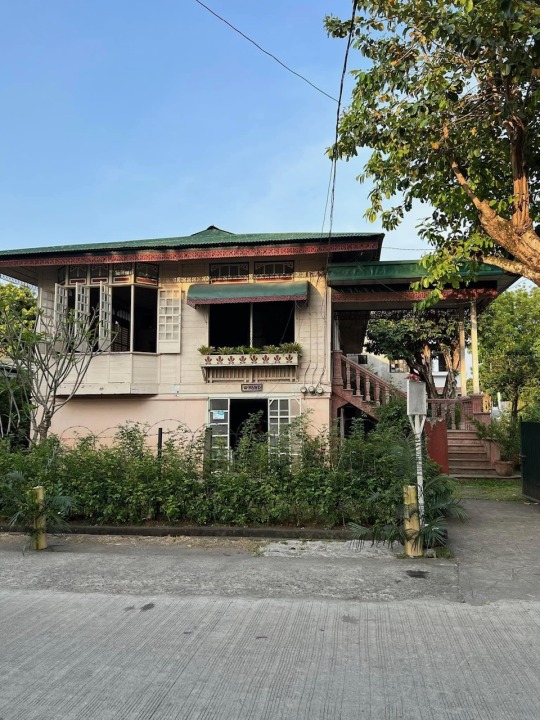
Lola’s house (Corazon Rivera Ancestral House) is considered ancestral because it is more than 50 years old and still belongs to the fourth generation of the family. It is a heritage house because the architecture belongs to a certain period and it is inside the declared (Philippine National) heritage zone. It is “taga-gitna” (people with houses in the center of the town surrounding the main plaza are elite).
It was built around 1929-1930. Lola Loring said she was 12 years old when they - Lola Azon (Corazon Rivera), Lolo Ato (Renato Del Mundo, son of Corazon Rivera) and Lola Loring (Loreto Del Mundo, daughter of Corazon Rivera) started living there. The old municipal hall (municipio) used to be located in the property. Lola Azon’s property was where the main municipal hall is located now. Lola Loring said that Lola Azon did not want to build the house directly in front of the church because she felt that the sins being confessed will "boomerang" back to the house or something like that. Can you imagine if she did not exchange her property….we will be in the center of the town plaza.
Anyway, there was no architect hired and Lola Azon was assisted by her nephew Felimon Rebong ("Lolo Imon") who was an engineer, or still an engineering student at that time. The house was built during the American period so it is called a chalet. It had plumbing and electricity. For better air flow the windows were big and surrounded the house. The lower portion of the windows had “ventanillas” (little windows) covered with wooden sliding doors which can be opened too. The upper portion of the walls had open wood carvings.
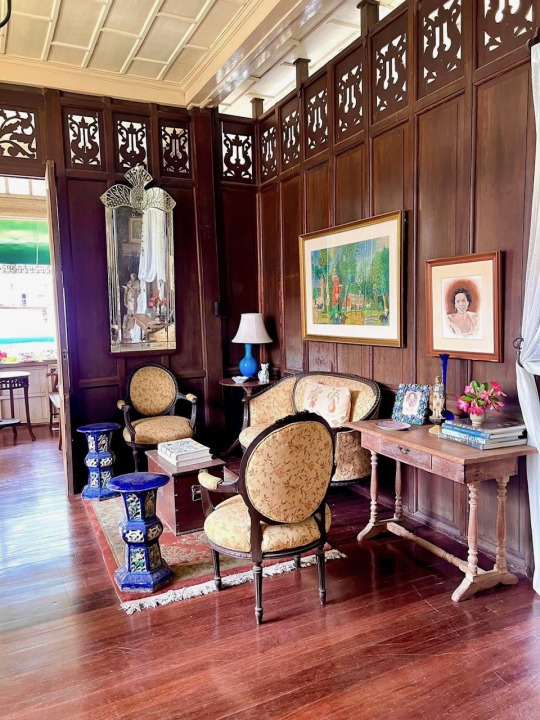
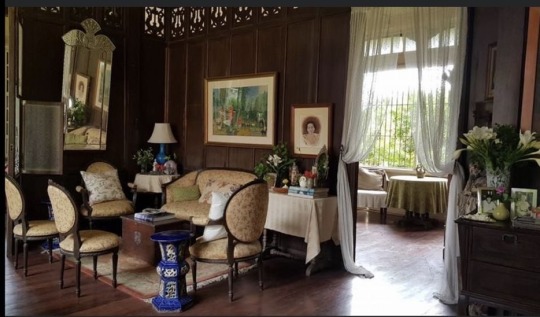
On the landing of the main stairs is the “balcon” (balcony) where one can sit to view the plaza. Aside from the main door there is also a door that leads to the first room. There were three rooms before with small doors leading to each room (the word “privacy” did not exist). The first one that opens to the balcon was occupied by Tita Jovit (Jovita, Cora's sister) and myself. The second one that opens to the sala/living area was occupied by Lola Azon and Tio Ato and family when they visited and the third one which opens to the comedor/dining area was occupied by Lolo Judge (Ramiro Relova, Loreto's husband) and Lola Loring. The 3rd room has a door that connects to the toilet/bath. (I recently had a division made to make the toilet separate from the bath during the renovation of the house).
There is no partition between the sala and comedor. When we were young a cabinet was used as partition. The front of the cabinet faced the dining room. The back of the cabinet faced the living room and the old piano was placed there. Actually the furniture pieces were moved around. The location of the living room set now is the best placement.
There was a sliding door that was the partition between the dining room and the kitchen. The kitchen was smaller until Lola had it renovated. We had no gas or electric stove. We had a “Kalan” (clay stove) that was made of ash. Charcoal, firewood and “bunot” (coconut husk) were used as fire. I remember that there were three parts so three dishes can be cooked at the same time. Can you imagine how hard it was then? Often there was a lot of smoke but there was a continuous flow of air then so it was not so bad. It is said that the food taste better with this method of cooking.There was also a storage room in the kitchen for (rice) “bigas”, salt etc. and I think a motor to pump water up the house. The pipes of the house was connected to free flow water fountain in the plaza. There was a stair in front of the toilet/bath used to go down to the first floor “silong” (basement).
The “silong” was where the "katulong" (household help) stayed, where the “sampayan” (clothes line when it rains) was, and the “bodega” - storage for the newly harvested and unmilled rice” palay”. Large blocks of ice were also stored there, covered by palay husks (and they never melted!) Lola Loring also had pens for hens that laid eggs and chickens for our food. I hardly went down because the flooring was not yet cemented and it was a bit dark.
Lola Azon planted a number of fruit trees. We had macopa (java apple), suha (grapefruit), lanzones (similar to lychee), balimbing (star fruit), duhat (java plum), santol (cotton fruit) and yambo (plum apple). Only the macopa (as old as the house) and the balimbing survives. The duhat in front of the house (by the gate) is only around 20 years old.
There was a “labahan” wash area for clothes at the back of the house. There was a continuous flow of water because of the pipe that was connected to the free flow fountain. There was a huge “kawa” or cauldron where the water fell and we (Tita Jovit and Tito Vic - Vic Del Mundo, Cora's first cousin and son of Renato Del Mundo) used to pretend “swim” or just fooled around and bothered the lavandera (washer woman) . Sadly, I do not know what happened to the “kawa”.
General cleaning of the house was done twice a year, certainly before the Flores de Mayo and I think after the New Year. Wives of tenants would come (around 4 ladies) and would work for free but they are fed very well and given travel fare and rice to bring home. It is called “panunulungan”. The ladies used “is-is” (ficus leaves) to scour the “pasamano” (window sill) and the floor before waxing. They used “walis na tingting” (broomstick) for the ceiling, walls, iron works followed by “basahan” (rag) soaked in water with soap in “palangana” (basin). I think it took them 2 days to clean everything. Then a male "katulong" (hired help) would wax the floor manually (very labor-intensive), then used “bunot” (coconut husk) to make it shine “lampaso”. I loved the smell of floor wax and the super clean house. One of the ladies was Aling Dulay who loved to bring Michael (Cora's son) fresh eggs.
I also remember that there was a carpet for the sala set. For cleaning the help would hang it on two chairs on the sidewalk in front of the house and beat it with a walis na tingting (broomstick). The lavandera (washerwoman) would also use the sidewalk to sun-dry clothes before rinsing.
Lola Azon would sweep the leaves on the ground with “walis tingting” everyday at around 4pm and I loved helping her. The leaves were piled up and burned because it drove the mosquitoes away. Every household did it. But in modern times, due to global warming and fumes, the municipal government forbade the burning of anything.
The wood used for the building of the house was mainly narra. Lola Loring (Loreto Del Mundo, daughter of Corazon Rivera) said that the panels with carvings that divides the rooms from the sala and comedor were made in Paete, Laguna. The windows in the rooms are made of wood with capiz shells. The flooring is also made of narra planks and the ceiling is made of wide solid narra. I remember that the materials used for the lower portion were not sturdy so it was cemented to better support the house.
After lunchtime and cleaning the kitchen was done, the help would iron clothes in the kitchen area with a plantsadora (iron). I remember that before the electric iron a heavy metal contraption with wood handle filled with burning charcoal was used (now considered an antique). The help would also listen to telenovelas on the radio. We were required to have an afternoon nap “siesta”, and we laid on banigs (woven mast) spread out in the living room.
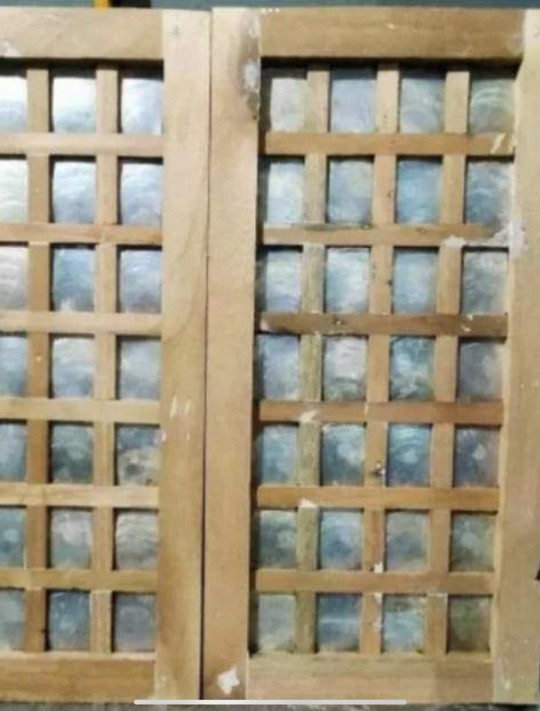
Capiz Shell Window
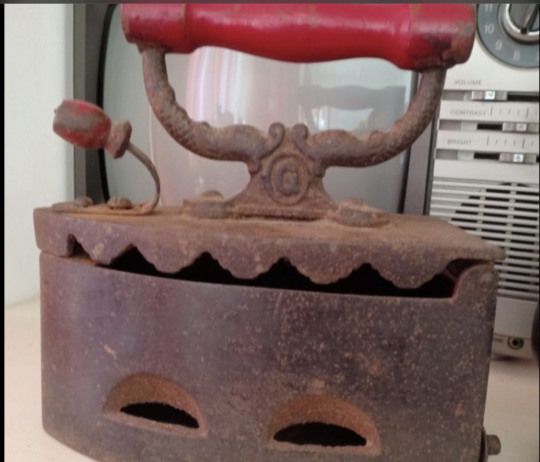
Plantsadora (Iron), image from Cora Relova
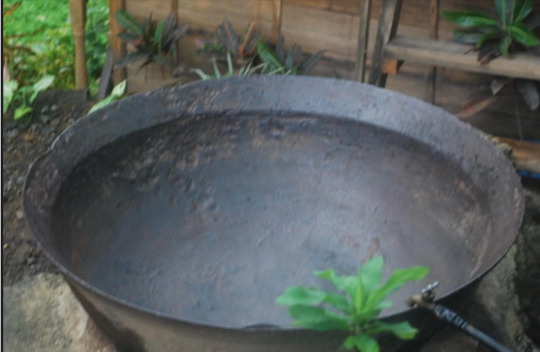
Image of a Kawa, uncredited photo
#pilalaguna#pila laguna#pila laguna history#philippine history#pila laguna town#pila laguna museum#pila laguna church#pila laguna philippines#pila laguna ancestral houses#pila laguna heritage houses#Corazon Rivera Ancestral House
3 notes
·
View notes
Text
Corazon Rivera Ancestral House: Furniture 2
Antique furniture in the Corazon Rivera Ancestral House, Pila, Laguna. Images from Cora Relova of the Pila Historical Society Foundation.
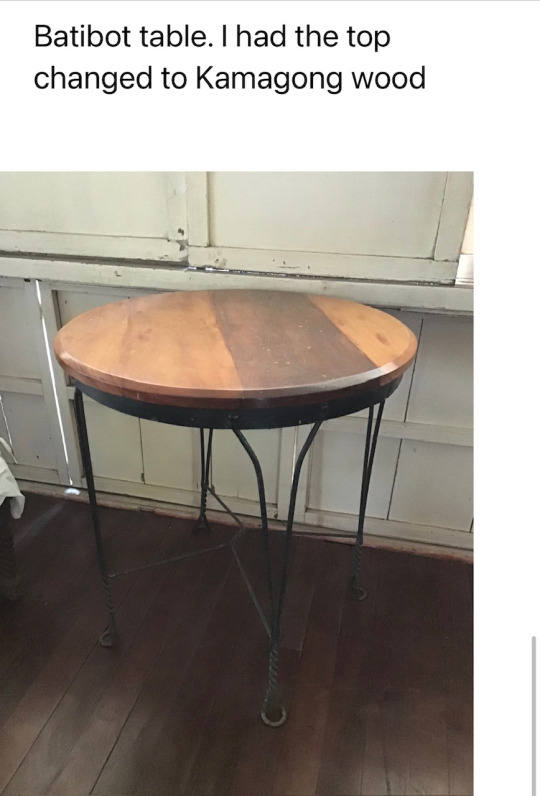
Side Table
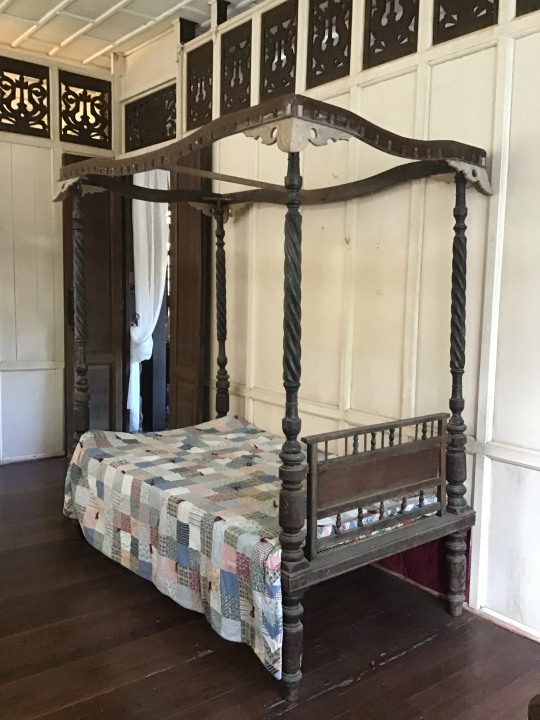
Narra antique bed. Lola Loring (Loreto Del Mundo, Corazon Rivera’s daughter) bought this. Probably 1920’s.
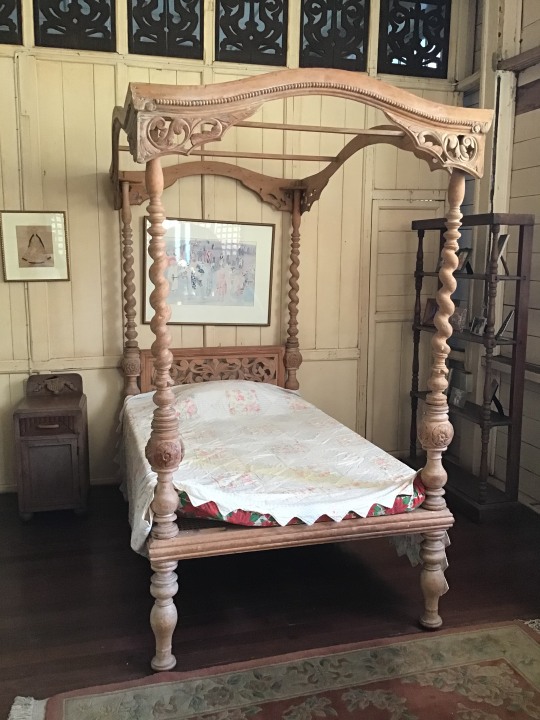
Narra bed of Lola Kikay, mother of Lola Azon (Corazon Rivera). Late 1800’s. Corazon Relova, her granddaughter, was born on this bed.
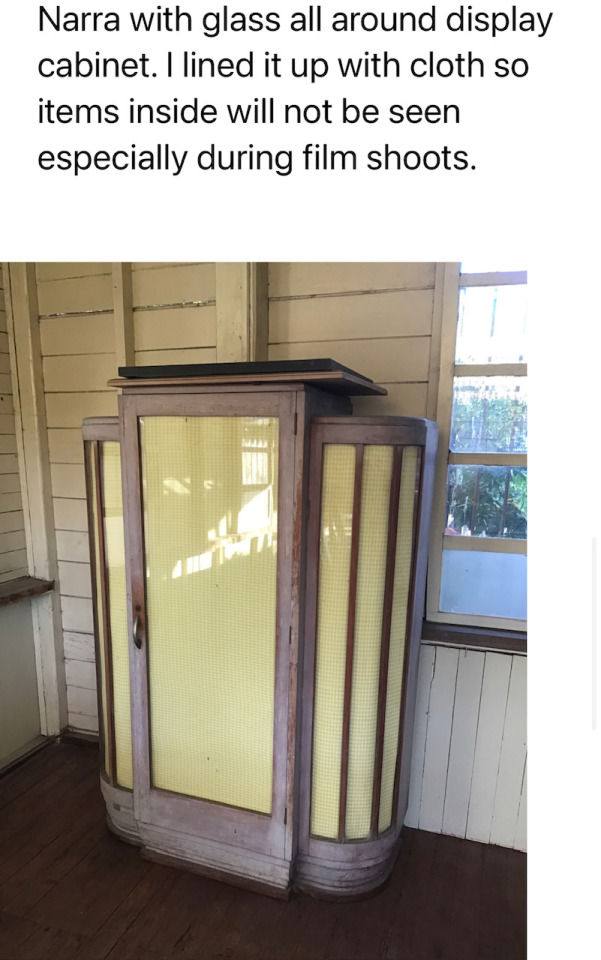
Narra Glass Cabinet
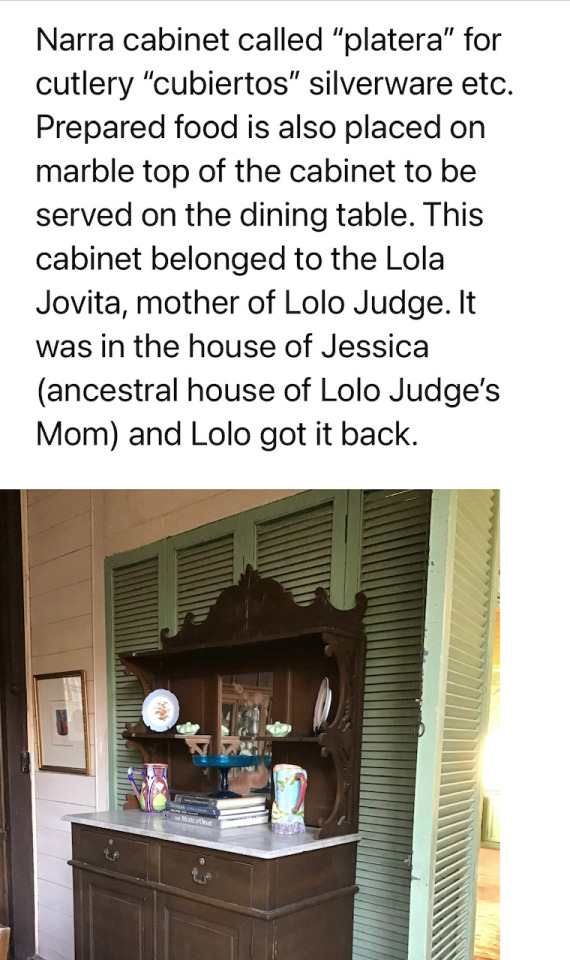
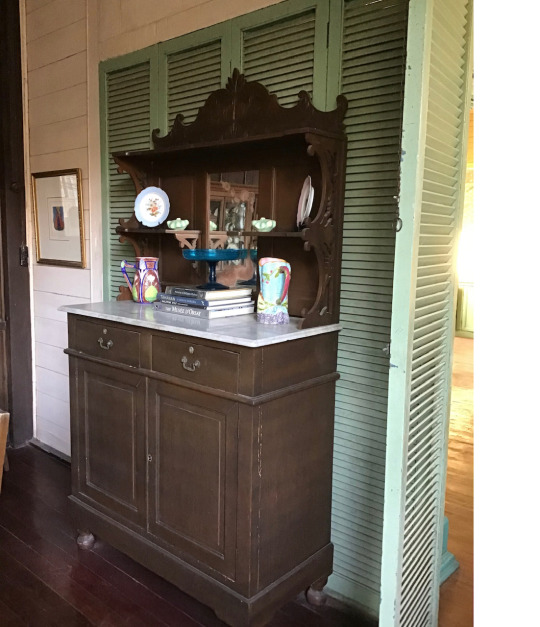
Platera (for plates, cutlery)
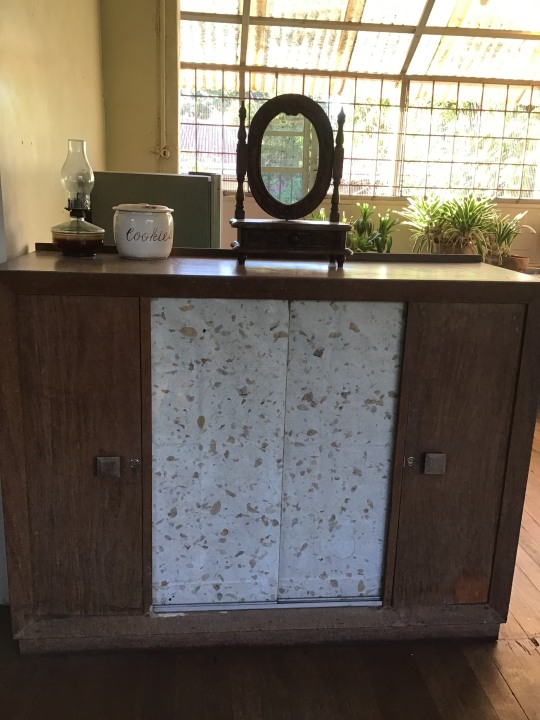
Narra cabinet. 1950’s. Lola Loring (Loreto Del Mundo, Corazon Rivera’s daughter) bought it in Ermita, Manila
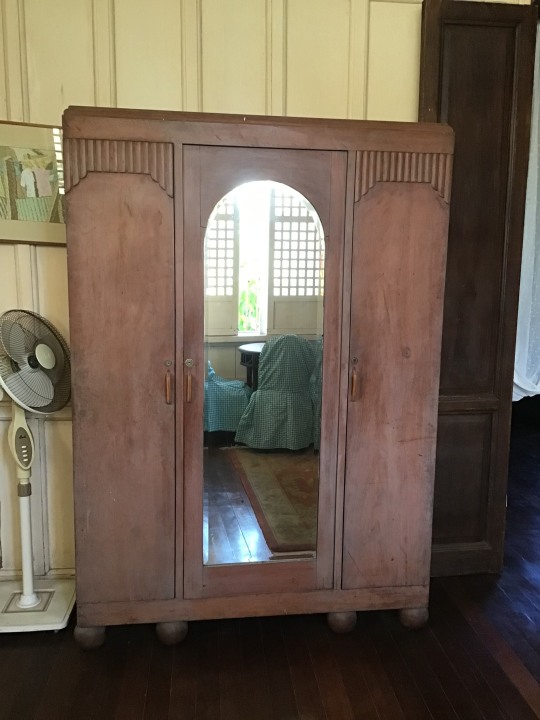
Lola Loring’s (Loreto Del Mundo, Corazon Rivera’s daughter) Narra cabinet from her mother.
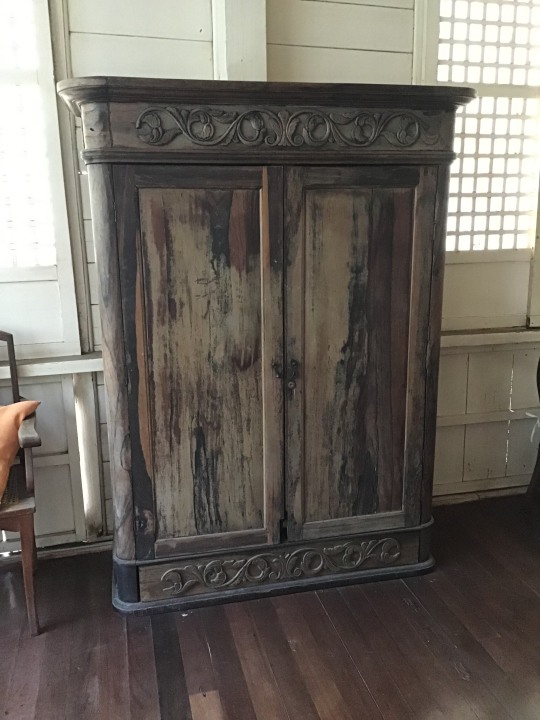
Camagong cabinet. It belonged to Lola Punday who is the grandmother of Lola Azon (Corazon Rivera). Probably close to 200 years old.
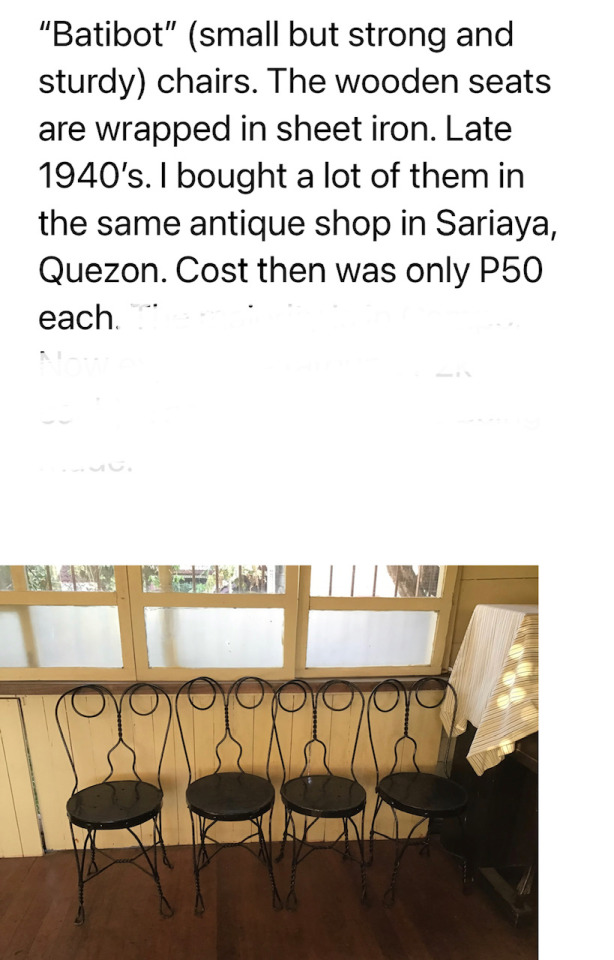
Batibot Chairs

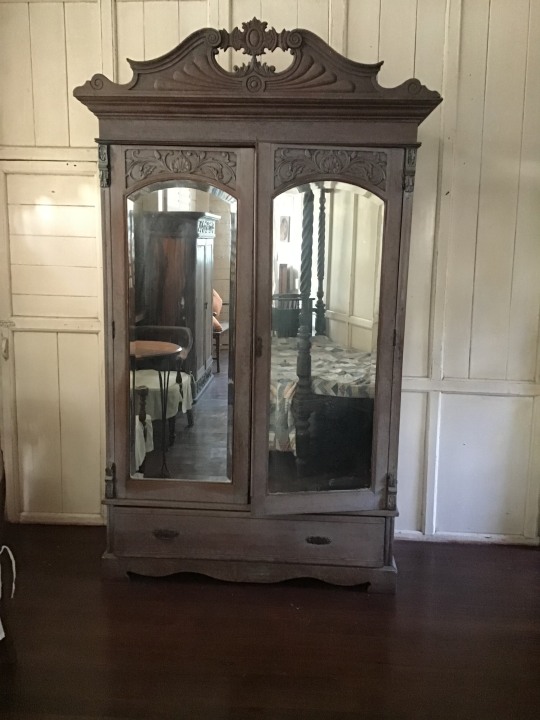
(Corazon Rivera) Lola Azon’s Narra cabinet. Probably 130 years old.
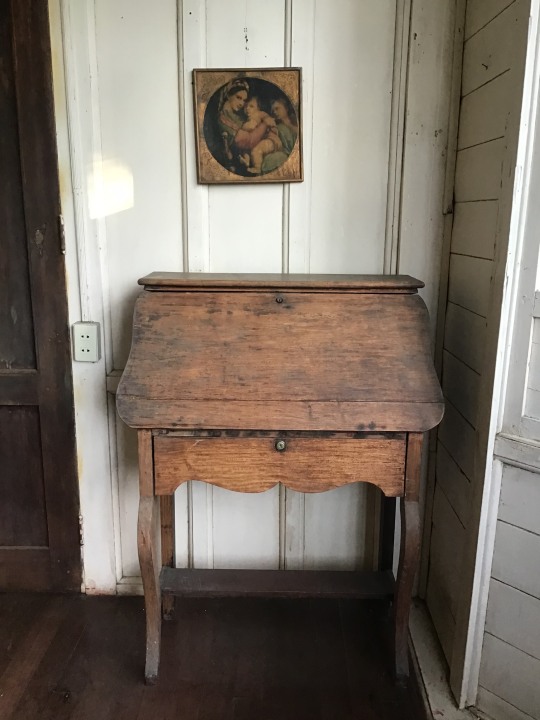
1940s Narra Desk
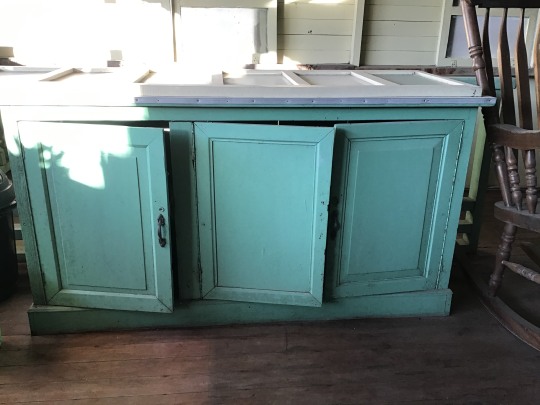
1960’s kitchen cabinet
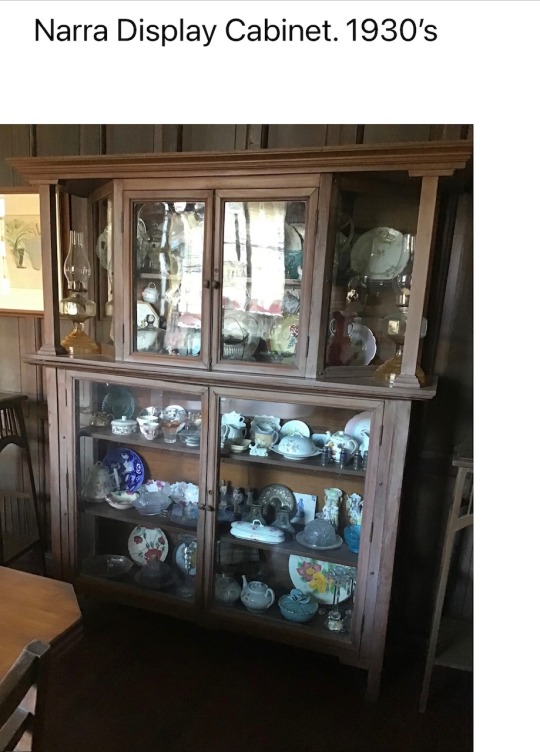
Display Cabinet
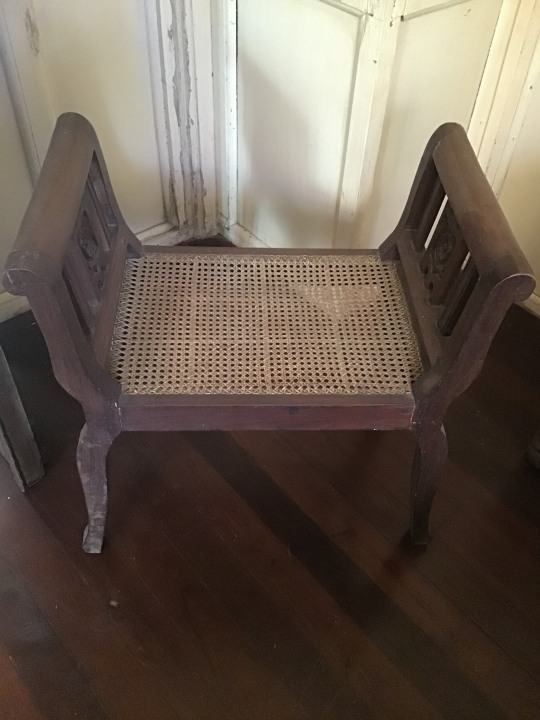
Narra Chair
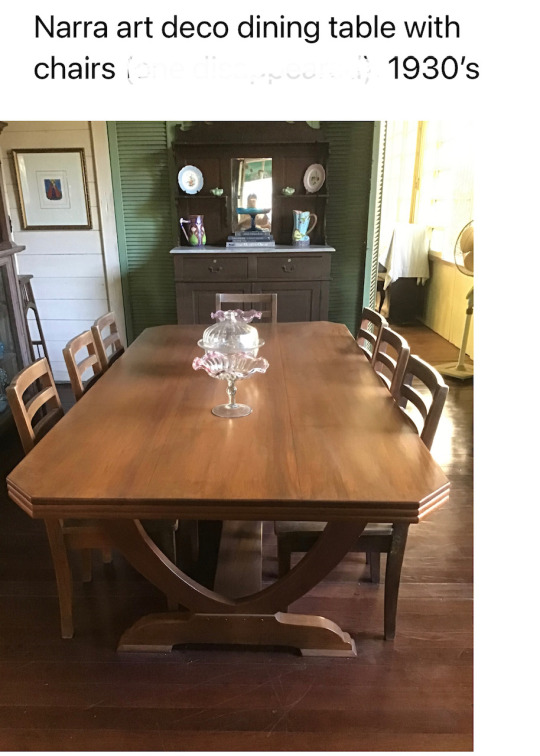
Dining Table
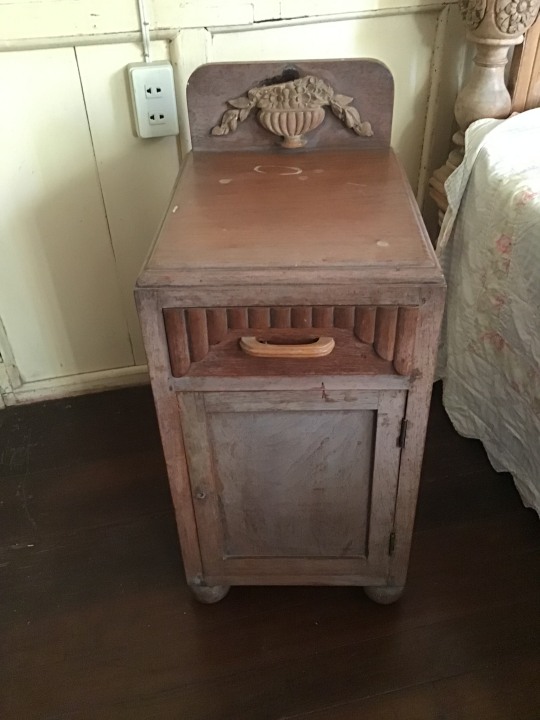
Narra night table
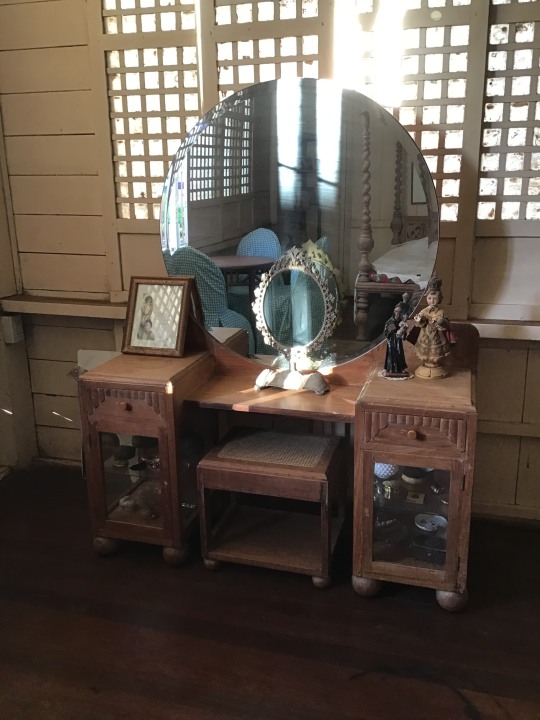
Narra dresser or “tocador” with a stool
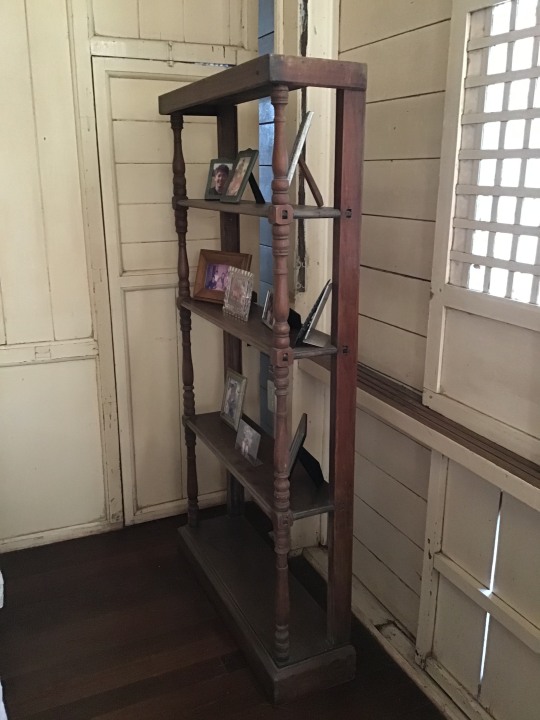
Narra pillow rack. Probably 1930’s. Now used for displaying pictures.

Narra Table
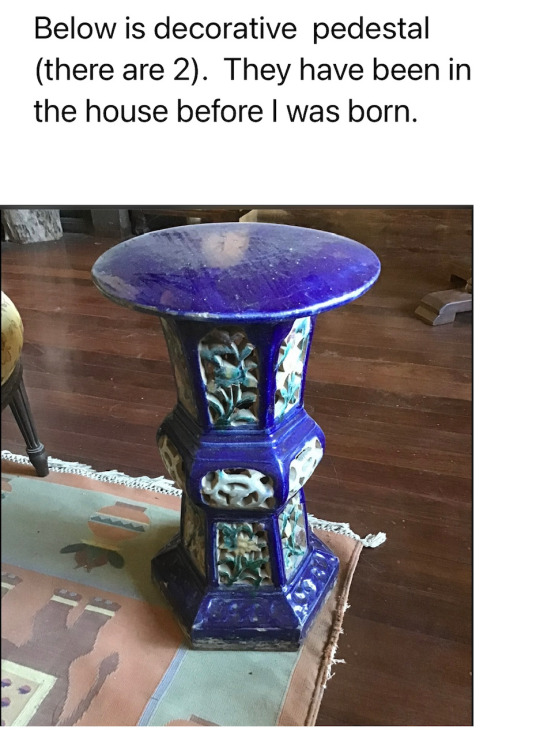
Antique Decorative Pedestals
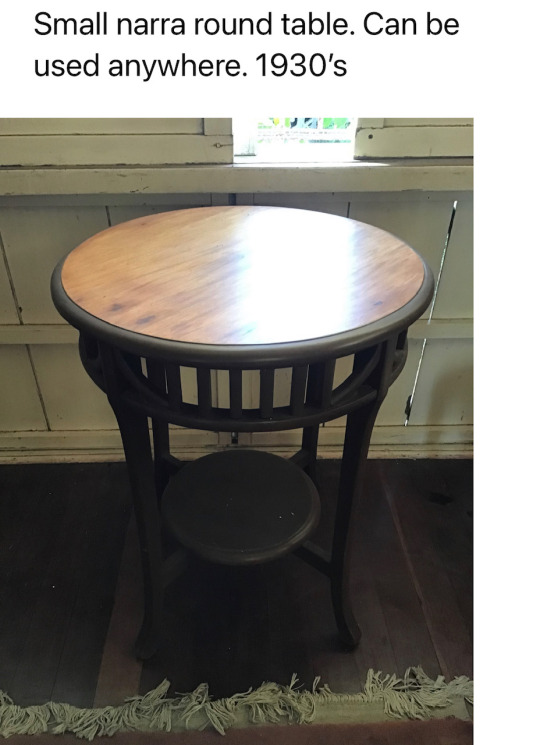
Narra Table
#pilalaguna#pila laguna#pila laguna history#philippine history#pila laguna town#pila laguna museum#pila laguna church#pila laguna philippines#pila laguna ancestral houses#pila laguna heritage houses#Corazon Rivera Ancestral House
0 notes
Text
Corazon Rivera Ancestral House: Garden
From Cora Relova of the Pila Historical Society Foundation:
Our garden had a lot of flowers mostly planted along the fence and around the main stairs. A thick bougainvillea plant covered the upper portion of the stairs (sadly it was removed because of termites).
There were lots of butterflies and 3 kinds of dragonflies “tutubi” in Tagalog - big and medium. The small ones (damselflies) were called “tutubing karayom” (needle). Lots of frogs croaking and crickets (kuliglig) chirping can be heard throughout the night. Since there were many trees bats who love to eat the fruits, they would go into the house. The helps would chase them out with walis na tingting (broomsticks). Lots of lizards crawled all over the ceiling and they would eat all the insects that came their way. There was also papua plants below the windows. It was used for sunning pillows and mats (banigs) to remove molds and odors.
Lola Azon (Corazon Rivera) planted a number of fruit trees. We had macopa (java apple), suha (grapefruit), lanzones (similar to lychee), balimbing (star fruit), duhat (java plum), santol (cotton fruit) and yambo (plum apple). Only the macopa (as old as the house) and the balimbing survives. The duhat in front of the house (by the gate) is only around 20 years old.
Sadly grasshoppers are gone due to pollution.
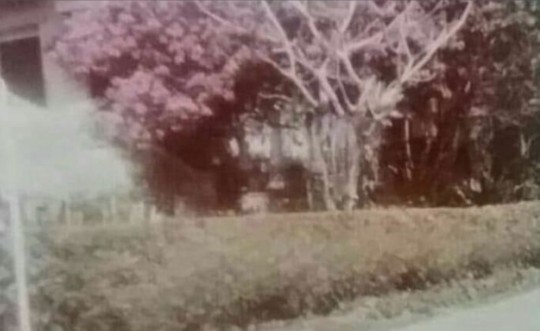

#pilalaguna#pila laguna#pila laguna history#philippine history#pila laguna town#pila laguna museum#pila laguna church#pila laguna philippines#pila laguna ancestral houses#pila laguna heritage houses#Corazon Rivera Ancestral House#Pila Laguna Plants
0 notes
Text
Corazon Rivera Ancestral House: Furniture
From Cora Relova of the Pila Historical Society Foundation: According to Lola Loring (Loreto Del Mundo Relova, daughter of Corazon Rivera) this European style sala set composed of a sofa, 2 armchairs and 3 chairs was purchased during the Japanese occupation (around 1943) by Lola Azon (Corazon Rivera's nickname) from a Spanish couple who lived in Ermita, Manila. The set was a wedding gift to them. They had recently celebrated their 50th wedding anniversary and decided to go back to Spain. So the set is around 130 years old. It was reupholstered 3 times and the last one was around 2015. I chose the material and bought it with Tita Jovit (Cora's sister) at a store for curtains and upholstery in Manila. The upholstery was done by the sister of Lek (Annie’s husband - Cora's niece). It is in delicate condition so I did not allow it to be used during film and commercial shoots. Interior and furniture designer Budji Layug said that the set has perfect proportion. The dining chairs made of narra used to be in our house in San Lorenzo Village, Makati.

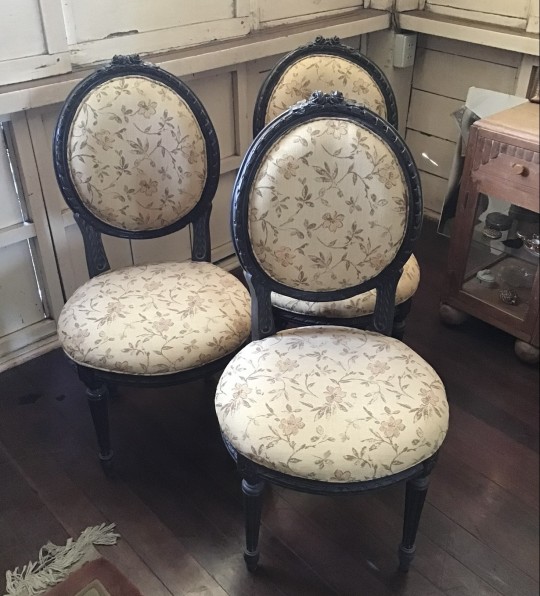

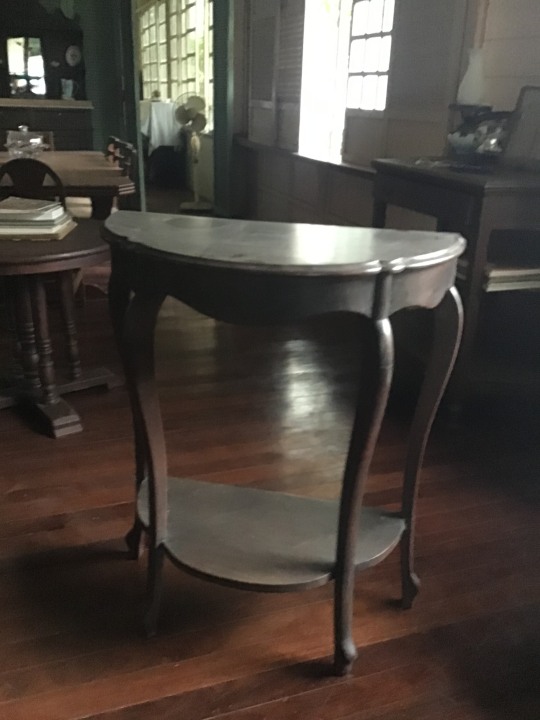
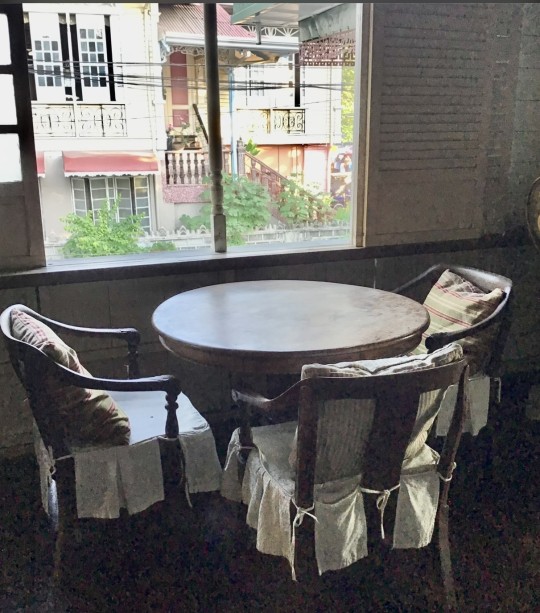
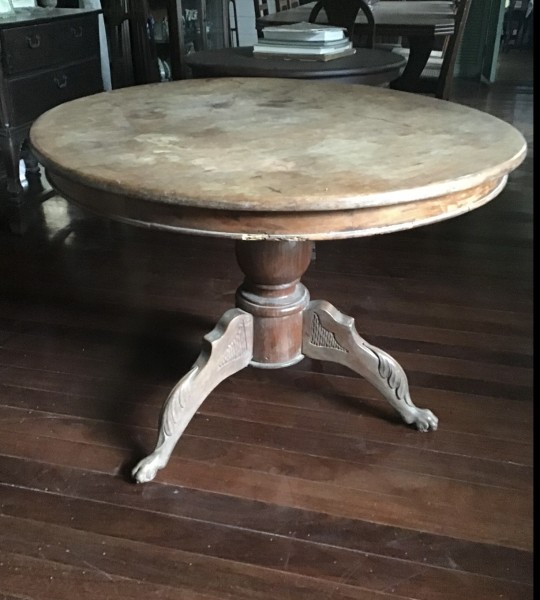

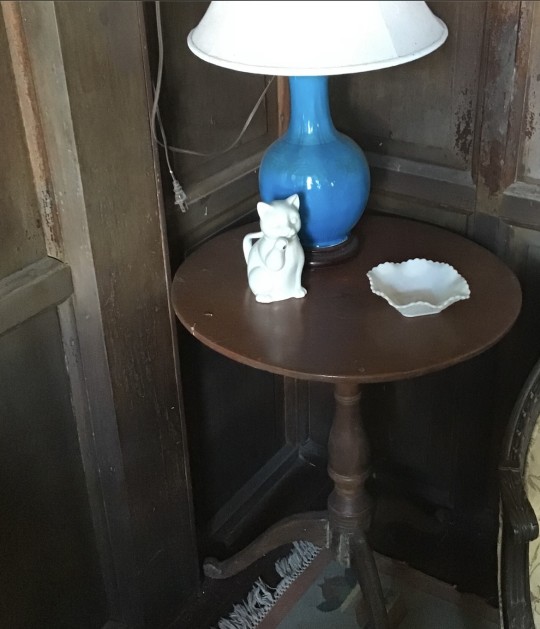
Tables are made of narra wood and probably 1920s-1930s. The small rectagular table is called Narra Lamesita.
#pilalaguna#pila laguna#pila laguna history#philippine history#pila laguna town#pila laguna museum#pila laguna church#pila laguna philippines#pila laguna ancestral houses#pila laguna heritage houses#Corazon Rivera Ancestral House
1 note
·
View note
Text
More Links 2
Mystery of the Remains of Don Felizardo de Rivera
Cemeteries of Pila
Don Juan de Rivera
Don Felizardo de Rivera
Laguna Myths and Legends: Secret Tunnels
Bahay ni Tisa is not in Pila Laguna
A Pila Schoolgirl's Autograph Book
Corazon Rivera (1888-1979) and the Corazon Rivera Ancestral House
Pila Ancestral Photos 1: Rivera, Alava, Agra Families
Pila Church: Past and Present
Pila Family Tree 1
"Gitna": The Rivera and Relova Ancestral Houses in Pila, Laguna (in Tagalog)
Pila Family Stories: Rivera Family of Pila Laguna
Pila Ancestral Photos 2: Alava and Relova Families
Property Tax Rates in Pila, Laguna, Philippines in 1909
Pila Artifacts at the University of San Carlos Museum, Cebu City, Philippines
Puliran in the Laguna Copperplate Inscription is the Laguna de Bay by Jaime F. Tiongson
Pila, Laguna (c1610), one of the historic Eight Spanish Villas in the Philippines
Laguna Copperplate Inscription: A New Interpretation Using Early Tagalog Dictionaries by Jaime F. Tiongson
The Restoration of Pila by Elizabeth S. Timbol
Pila’s Ancient Jar Burials
Pila mentioned in Precolonial Tagalog Counting and Marking Time Research
Datu of Pila in Filipino Class Structure by William Henry Scott
How to address a Datu of Pila
The Practice of Manda
Ruins of Old Stairs
Pedro del Mundo Family History
Pila Laguna Trivia
Easter Sunday in Pila, Laguna, 1975
Pila Videos
Corazon Rivera Ancestral House: Furniture
Corazon Rivera Ancestral House: Furniture 2
Corazon Rivera Ancestral House: Garden
Life in the Corazon Rivera Ancestral House
The Spring Well of Pila
The Pila Marker
Pila Museum Restoration
A Pila Wedding
The Chinese in Pila
A Childhood Pic with my Grandfather, Judge Ramiro Relova
All Saints Day Ancestral Graves: Rivera, Relova, Alava Families
#pilalaguna#pila laguna#pila laguna history#philippine history#pila laguna town#pila laguna museum#pila laguna church#pila laguna philippines#pila laguna ancestral houses#pila laguna heritage houses#Felizardo de Rivera#Pila Town Plaza#San Antonio de Padua church#Pila Laguna Cemeteries#Don Juan de Rivera#Don Felizardo de Rivera of Pila#Pila Laguna Ancestral Photos#Rivera Family Pila Laguna#Relova Family Pila Laguna#Alava Family Pila Laguna#Agra Family Pila Laguna#ancient pila laguna#Corazon Rivera Ancestral House
1 note
·
View note
Text
Pedro del Mundo Family History
Pedro del Mundo was the husband of Corazon de Rivera, the direct descendant of the founder of Pila, Don Felizardo de Rivera.

Pedro del Mundo was a former mayor and governor of Boac, Marinduque, Philippines.
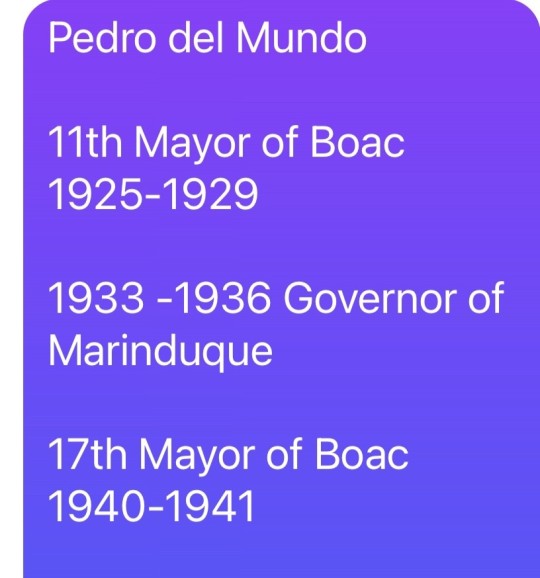
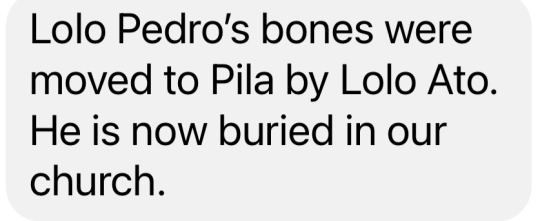
Pedro del Mundo's remains were interred in the Pila Church by his son, Renato "Lolo Ato" del Mundo.
He is the father of Loreto del Mundo Relova who married former Pila Judge Ramiro "Raming" Relova and Renato "Ato" del Mundo who married Marina Llamas, sister of Virginia Llamas Romulo, wife of Carlos P. Romulo, Former President of the United Nations General Assembly in 1949 to 1950 and as president of the UN Security Council in 1957, 1980 and 1981.
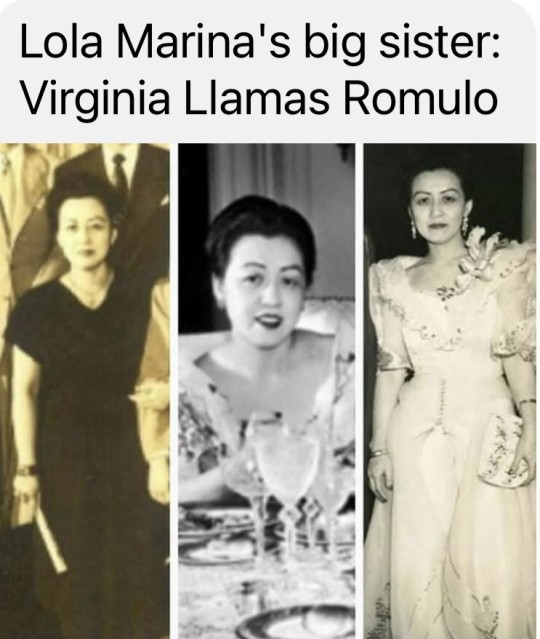
There is a Del Mundo family plot in Boac, Marinduque. Photos from Cora Relova and Jheng Miranda.
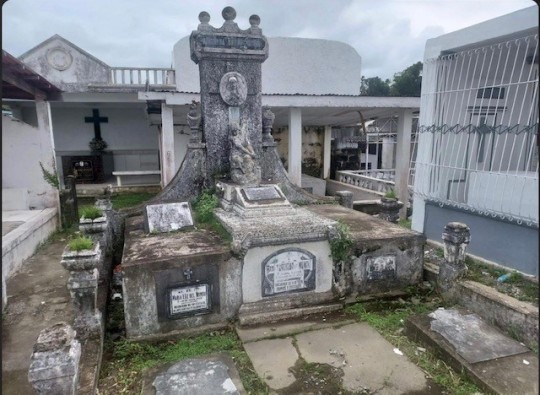




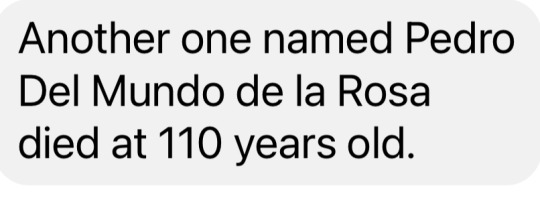


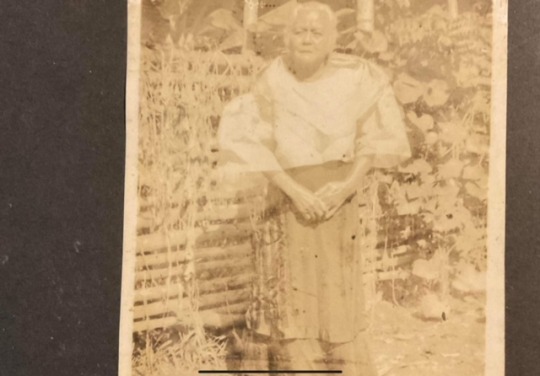
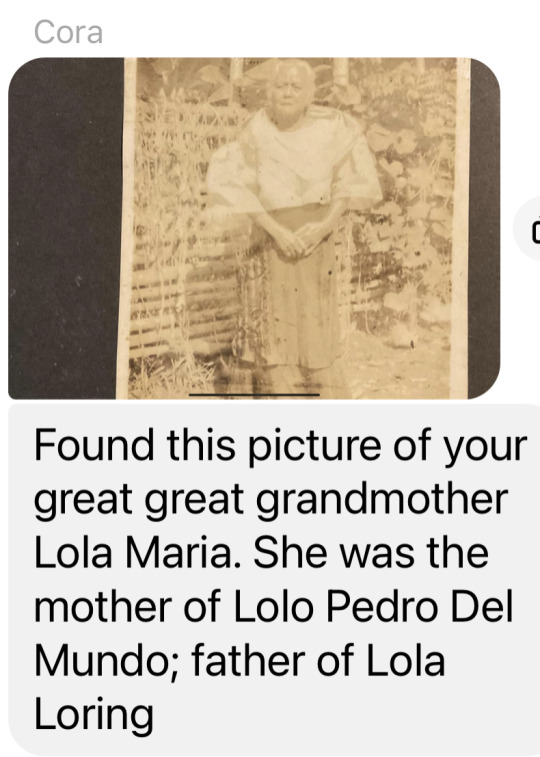
Tomas del Mundo was the municipal president of Boac, 1901.
Pedro del Mundo and María Meléndez had a son, Remigio del Mundo y Meléndez.
Remigio del Mundo married Martiniana Lualhati and had a son, Don Bernardo Lualhati del Mundo who was a Filipino lawyer and politician with the Philippine Assembly from October 16, 1912 to October 16, 1916.
Bernardo del Mundo married Paz Villanueva del Mundo and had a daugher, Fé Primitiva del Mundo y Villanueva who was a Filipina pediatrician and founder of the first pediatric hospital in the Philippines. She was born on November 27, 1911 in Intramuros, Manila, Philippines and died August 6 2011 (aged 99), in Quezon City, Philippines.
Fe del Mundo is the second cousin of Loreto del Mundo Relova, daughter of Corazon de Rivera, wife of Pedro del Mundo. Maria Luz del Mundo is the mother of Pedro del Mundo.

Marina Del Mundo, wife of Renato "Ato" Del Mundo. Photo from Bel Tomas Ranosa.




Photos from Bel Tomas Ranosa.
#pilalaguna#pila laguna#pila laguna history#philippine history#pila laguna town#pila laguna museum#pila laguna church#pila laguna philippines#pila laguna ancestral houses#pila laguna heritage houses#Pedro del Mundo Family#Corazon Rivera Family
0 notes
Text
Pila Ancestral Photos 2: Alava and Relova Families




From Lia Scott Price, great-granddaughter of Corazon Rivera, granddaughter of Loreto del Mundo Relova and daughter of Cora Relova. Pictured is the bedroom in the Corazon Rivera ancestral house. (Photo by Jessica Rivera).



Childhood pic of Pila Historical Foundation Advocate Cora Relova

From Melvyn Relova: former Philippine Supreme Court Justice Lorenzo Relova and Family
#pilalaguna#pila laguna#pila laguna history#philippine history#pila laguna town#pila laguna museum#pila laguna church#pila laguna philippines#pila laguna ancestral houses#pila laguna heritage houses#Alava Family of Pila Laguna#Pila Laguna Ancestors#Relova Family of Pila Laguna#Agra Family of Pila Laguna#Rivera Family of Pila Laguna
0 notes
Text
More Articles and Links
What Early Tagalogs Worshipped
The Gold-Rich Datu of Pila and Philippine Gold Pila's Historical and Archeological Importance Ancient Tagalog Shamans: The Babaylan
The Relic of St. Anthony of Padua
Pila's Antique Statue of the Virgin Mary Pila's Antique Four-Poster Beds
Pila's Antique Statues: San Antonio de Padua
The Street Vendor
Pila Laguna History: A Summary
Pila Photos Medicines of the Lolas (Grandmothers)
Capiz Shell Windows
Pila in the 1980s The Pila Marker The Banga and Tapayan (Water Jug) Lizards in Pila: Tuko and Butiki
Polvoron
The Kawali
The Banig
Pila Memories: Kitchen Items The Bunot Sa Sahig: Coconut Husk Floor Buffer
Plantsang de Uling (Clothes Iron) Animals of Pila: Owls
Pila Convent
Campo, the Last Ancestral Land in Pila The Pila Arch Pila's Ancient Rituals Pila History: Some of the Oldest Houses in Pila 2
Pila's Antique Saints: Santisimo Niño Jesus Dormido
What is Pila, Laguna known for?
Pila: A Book and a Plaza
The Ancient Gold of Pila
Cora Relova: Life, Art and Architecture in Historic Pila
Walkabout in Pila, Laguna's Town Plaza Investigative Documentaries: Pila, Laguna: Progressiveness through preserved heritage How to maintain an Ancestral Home Cleaning a Pila Ancestral House Ceiling A Childhood in Pila, Laguna
Hungry for Laguna More Antiques of Pila: The Aparador
Common Childhood Memories of Pila Plants of Pila
Pila History: The American Era Part 2 The Crypts of Pila
Pila Memories: Basketball and Cotton Candy
The Ancestral Houses of Pila, Laguna
Heritage Town of Pila, Laguna
Antique Photos of Pila Town Mayors and Leaders Pila Historical Society Foundation History Poem for Pila Easter Sunday in Pila, 1970s Pila Architecture: Corazon Rivera House Holidays in Pila The Rivera Sisters of Pila, Laguna Facts about Pila, Laguna Huerta's Villa de Pila
Pila's Franciscan Printing Press History
How Burzagom Street got its Name Pila Memories: Holy Communion The Fuentes-Carillo House 1600s Document describing the Pila Choir Pila Memories: Holy Communion The Fuentes-Carillo House
Pila's Rio Nuevo The Angelus Pila, a Historical Landmark that withstood War, Time Judge Ramiro Relova Wedding Photo The Pila Pipe Organ Makahiya Memories Pileños in History: Cora Relova Pila Digital Historian: Lia S. Price More Old Images of the Pila Church Pila Ancestors Animals of Pila: The Cane Frog Pila's Heritage Keepers The Pila Population in 1818
The Pila Population in 1903 The Restoration of Pila
Pila's Spanish Colonial Town Planning System Inside a Pila Heritage House Vic Del Mundo, Pila's Floral Designer Ancestral Women of Pila: "Lola Doray" The Carrozza (Carriage) Foods of a Childhood Breakfast in Pila Pila's Old Basketball Court The Pila Symbol Pila's Designated Historical Structures Treasures of Pila
MORE ARTICLES AND LINKS 2
#pilalaguna#pila laguna#pila laguna history#philippine history#philippines#Pila Laguna Town#Pila Laguna Ancestral Houses#Ancient Pila Project#Pila Laguna Church#Pila Laguna Philippines#Pila Laguna Heritage Houses#Pila Laguna Museum#datu of pila laguna#pila laguna datu#Pila Laguna Flores de Mayo#pila laguna town plaza#pila historical society foundation#Rivera Family Pila Laguna#Relova Family Pila Laguna#Alava Family Pila Laguna#Agra Family Pila Laguna
4 notes
·
View notes
Text
Pila History: The American Era
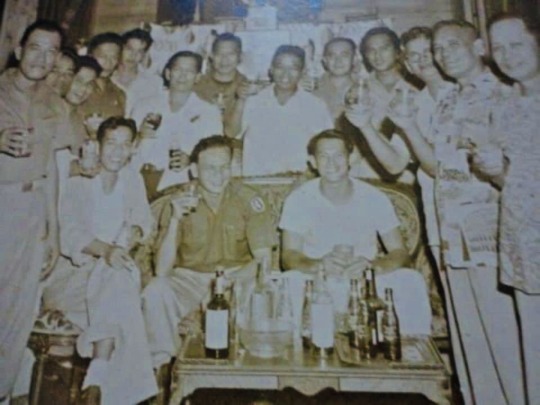

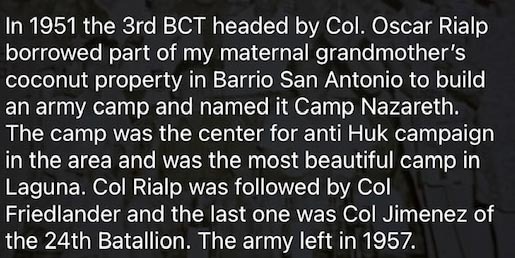
"The Most Beautiful (Army) Camp in Laguna", 1951-1957
In 1951, after the liberation of the Philippines from the Japanese and during the American Occupation, the USAFFE (United States Army Forces in the Far East) built an army camp on the 5-acre ancestral land of Doña Corazon Rivera, daughter of Don Felizardo Rivera, Pila's Founder. They named it Camp Nazareth. It was in the middle of a coconut plantation, surrounded by rice fields and lush green vegetation with an amazing view of the sunrise and sunset. At the camp, the army also built a tennis court and a natural stone swimming pool (later replaced with tiles).
Camp Nazareth was occupied by the 3rd Battalion Combat Team (BCT). The 3rd BCT was an elite force, a special forces unit for Counter-Guerilla Operations. The guerillas they were sent to "dismantle" were the "Huks", short for Hukbalahap (Hukbong Bayan laban sa Hapon), a group originally formed to fight against the Japanese forces during World War 2, but who were now against the American occupation.
The BCT occupied Camp Nazareth from 1951, and left in 1957.
In the 1960s, Doña Corazon gave the land to her granddaughter, Cora Relova (Founder of the Pila Historical Society Foundation). Camp Nazareth was renamed "Campo", and Cora had a house built on the property, designed by Ariston Nakpil, an architect and son of the first Miss Philippines, Anita Noble.
Campo is now the only ancestral family land and estate from Don Felizardo that is still in the possession of his direct descendants. It is also the residence of Cora's father, former Judge Ramiro Relova.
Info and photo from Cora Relova of the Pila Historical Society Foundation
Pila in World War 2
During World War 2, Pila had an underground unit, the 45th Regiment Hunters, formed to defend against the Japanese occupation. The Hunters' members included Lt. Perfecto Rivera (Bn. S-1 and later, Bn. Executive Office), Lt. Jose "Jobo" Fernandez (Asst. Bn S-1), Capt. Jose Relova (Bn. S-4), and Lt. Jose Madrigal (Asst. Bn. S-4). (Zaide 1979, Gleeck 1981:106-113, Mojica 1965:570-607). An ex-Mayor, Don Mesiton Rivera (1926-28) survived an attempt on his life by Japanese collaborators.
The American Liberation, 1945
Pila was the first town in Laguna to be liberated by the Americans in January, 1945, suffering minor damage, and Pileños opened their homes to war refugees from other damaged cities like Manila. (Zaide 1979, Gleeck 1981, Mojica 1965).
Pileños attributed the miracle of the town being spared from destruction during the war to the intercession of their patron saint and protector, St. Anthony of Padua. A year after the liberation of Pila from the Japanese, Pope Pius XII declared Saint Anthony a Doctor of the Universal Church with the title "Doctor Evangelicus" on January 16, 1946, and Pila adopted the honorific "Bayang Pinagpala", "The Blessed Town".
Santiago, Luciano P. R. “THE ROOTS OF PILA, LAGUNA: A SECULAR AND SPIRITUAL HISTORY OF THE TOWN (900 AD TO THE PRESENT).” Philippine Quarterly of Culture and Society, vol. 25, no. 3/4, University of San Carlos Publications, 1997, pp. 145-147, http://www.jstor.org/stable/29792218.

Pileños in the Manila Carnival, 1908-1939
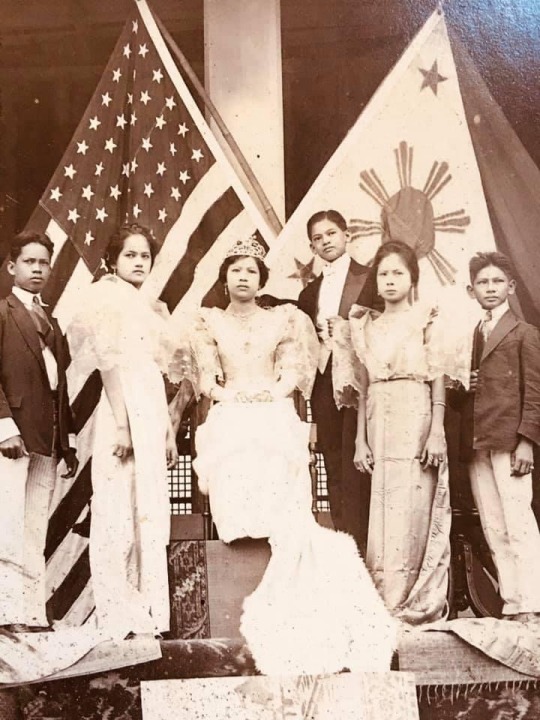
The Manila Carnival (1908-1939) was an annual festival held in Manila, Philippines, during the American Colonial Era and before WW2 to celebrate harmonious US-Philippine relations and showcased Philippine commercial, industrial and agricultural progress. The Carnival featured Carnival Queens of which women from Pila participated in.
Photos and info from Raffy Alava Antonio and the Pila Family Archives.
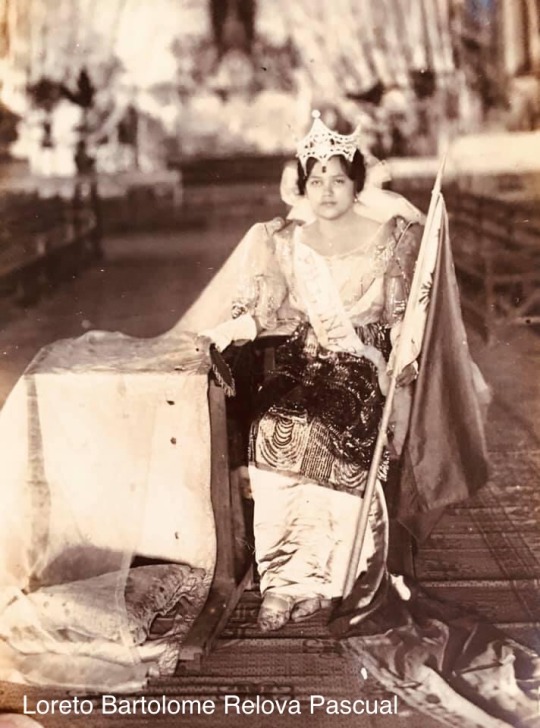
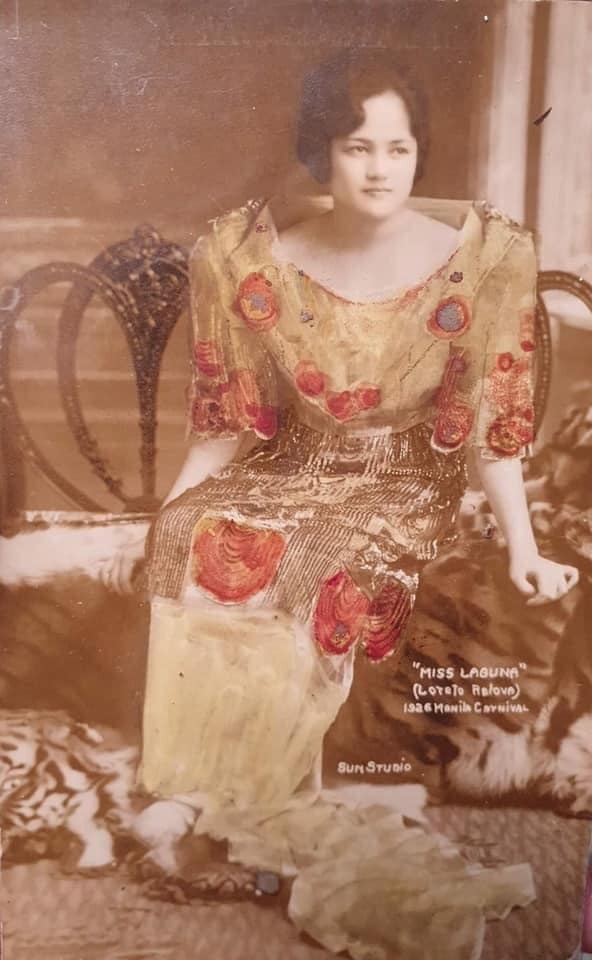
Loreto Relova, First "Miss Laguna", 1926 Manila Carnival.
Stories from the Japanese Occupation of Pila:

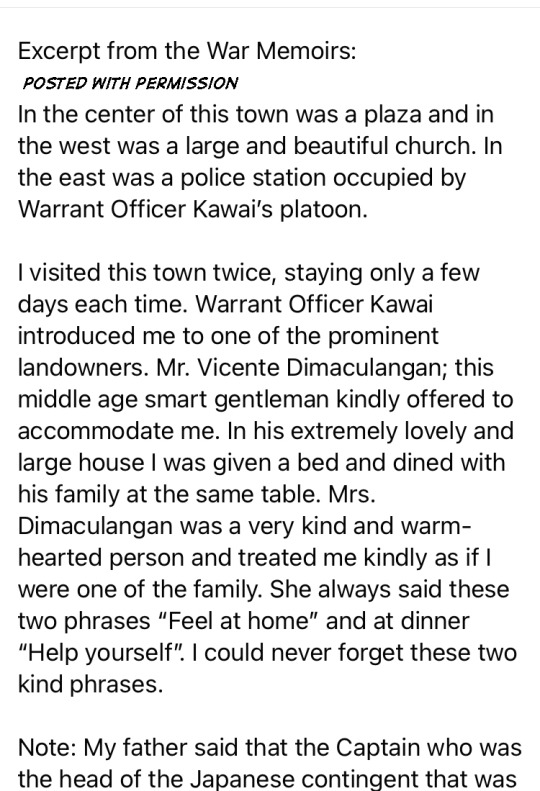

Pila History: The American Era Part 2
3 notes
·
View notes
Text
Campo, the Last Ancestral Land in Pila
Campo is the only ancestral family land and estate from Don Felizardo de Rivera, the founder of Pila, that is still in the possession of his direct descendants. It was also once the residence of Cora's father, former Pila Judge Ramiro Relova.
Campo Photos
Campo's Military History:
Historical Images
Campo was once called "The Most Beautiful (Army) Camp in Laguna" from 1951-1957". In 1951, after the liberation of the Philippines from the Japanese and during the American Occupation, the USAFFE (United States Army Forces in the Far East) built an army camp on the 5-acre ancestral land of Doña Corazon Rivera, daughter of Don Felizardo Rivera, Pila's Founder. They named it Camp Nazareth. It was in the middle of a coconut plantation, surrounded by rice fields and lush green vegetation with an amazing view of the sunrise and sunset. At the camp, the army also built a tennis court and a natural stone swimming pool (later replaced with tiles).
Camp Nazareth was occupied by the 3rd Battalion Combat Team (BCT). The 3rd BCT was an elite force, a special forces unit for Counter-Guerilla Operations. The guerillas they were sent to "dismantle" were the "Huks", short for Hukbalahap (Hukbong Bayan laban sa Hapon), a group originally formed to fight against the Japanese forces during World War 2, but who were now against the American occupation.
The BCT occupied Camp Nazareth from 1951, and left in 1957.
In the 1960s, Doña Corazon gave the land to her granddaughter, Cora Relova (Founder of the Pila Historical Society Foundation). Camp Nazareth was renamed "Campo", and Cora had a house built on the property, designed by Ariston Nakpil, an architect and son of the first Miss Philippines, Anita Noble.
Campo is now the private ancestral home of Cora and her children, Valerie Price (who now owns and maintains the Corazon Rivera ancestral house in Pila), Michael Price, and her eldest, “Dayang” Lia Price, who runs the Ancient Pila Project online museum. They are the direct descendants of Datu Maguinto and Don Felizardo Rivera.
-Info from Cora Relova of the Pila Historical Society Foundation

The ceiling of the Campo ancestral house, made of Anahaw (Fan Palm) leaves and wood. Anahaw is the Philippine National Leaf.
Judge Ramiro “Raming” Relova sitting with the Former Elite Special Forces Army in the former Camp Nazareth (now called “Campo”) and Rivera Ancestral Land. Photo from Cora Relova.
Campo house and land photos from Paolo Campillo.








#pila laguna history#pilalaguna#Pila Laguna#Pila Laguna Town#philippines#philippine history#ancient pila project#Philippine ancestral towns
0 notes
Text
The Bunot Sa Sahig: Coconut Husk Floor Buffer
The Bunot Sa Sahig is a coconut husk traditionally used to polish the wooden floors of ancestral houses. It is one half of a dried coconut shell placed face down on the floor. To polish the floor, one places their foot on the husk and moves it in a front to back sweeping motion, using red wax or candlewax to polish the wood until it shines.

The shiny floors of the Corazon Rivera heritage house in Pila, Laguna. Photo from Valerie Price.
1 note
·
View note
Text
Plants of Pila


Photo: The Macopa Tree (Java Apple) in the garden of the Corazon Rivera House.
The gardens of the ancestral houses of Pila contained:
Begonia
Balimbing (Carambola or Star Fruit)
Banaba Tree (Species of Crepe Myrtle Tree, blooms only during summer, seeds are spread by birds.)

Chico (Sapodilla, fruit of a species of Evergreen Tree)
Donya Aurora Flowers (White Mussaenda Evergreen Plant)
Gladiolus Flowers
Guava
Jackfruit
Kalachuchi (Frangipani or Temple Flower, a popular flower used in Pila's Flores de Mayo.)


Lanzones Fruit (a species of Mahogany)
Lukban (Pomelo)
Macopa (Java Apple)
Madre de Cacao
Malunggay (Horseradish Tree)
Santol Fruit (Cotton fruit)
Santol Fruit (Cotton fruit)
Starfruit (Carambola)
Santan Flowers (West Indian Jasmine)
Snake Plant (Tigre, Sansevieria trifasciata)
Yambo Fruit (A relative of the Guava)
Ylang-Ylang (Yellow Star-Shaped Flower)
Dried leaves were swept up and burned in the early mornings in the backyards.
Dried coconut husks were used to polish wooden floors ("Bunot sa Sahig). You would place your foot on the husk and scrub the floor in a sweeping motion. It was the early manual, leg-powered, floor polisher.
0 notes
Text
Pila History: Old Houses and the Parts of Pila’s Houses
Ancestral/Heritage Houses.
American Colonial houses: the architectural eras and styles of the houses of Pila.
Notable features are great stone staircases and capiz-shell windows, open upper-level spaces and ground levels for storage. It had a rectangular layout. The houses, built by the wealthy Principalia, stood on solid stone blocks as a foundation. The same architectural style was used for buildings such as schools, convents, and government buildings. These houses are called ancestral houses.
Photos from the Pila Family Archives




Staircase of the Corazon Rivera Ancestral House, built around 1928-1929. Photo from Cora Relova of the Pila Historical Society Foundation
Some parts of the Ancestral Houses are:
Azotea: balcony
Banggera: wooden dish rack

Bañera: bathtub
Baño: bathroom
Cocina – kitchen
Comedor: dining room

Cuartos: bedrooms

Escalera: stairway
Sala: living room

Mirador: tower
Oratorio: prayer room or shrine with santos

Puerta: entrance
Ventana: large sliding capiz-shell windows
Photos are from the Pila Family Archives
Pila’s Architectural Photos 1
Pila’s Architectural Photos 2
Pila’s Architectural Photos 3
Pila’s Architectural Photos 4
0 notes
Text
Pila at Hacienda Santa Clara, the Third and Present Location

“Nuevo Pila” (Image from Rivera Family Archives).
In 1804, Pila was moved for the third and final time from Pagalangan to Hacienda Santa Clara owned by the Don Juan de Rivera family of Pila.
Don Juan's descendant, Don Felizardo de Rivera (1755-1810), was at first a town executive from 1792 to 1793. During the town move, he had drawn up grid plans (Cuadricula) in 1790 for the new site (where Pila was to be moved) based on the classical Spanish system of 'church-plaza-town hall complex' as originally prescribed by the 'Laws of the Indies (1573)' (laws issued by the Spanish Crown for town planning). He had become a self-taught architect. When the transfer was officially sanctioned (approved), he implemented his plans by serving as gobernadorcillo (governor) in 1805, 1807, and 1809 (he died in 1810). Because of his orderly design (of the town), Don Felizardo is considered the founder of 'Nuevo Pila (New Pila).' Don Felizardo retained all the residential lots around the rectangular plaza between the church and the town hall for the ancestral houses. The principal street is christened 'Rivera', which connects (the town) 'like a long umbilical cord' (back to) Pagalangan. (Santiago, Ancient Pila, pg 25).
The Pila Municipal Hall was later built in June 1931, across from the Church, on land owned by Doña Corazon Rivera de Del Mundo, daughter of Don Luis Rivera. The town’s design had a rectangular town plaza, with the church and town hall on either end, and surrounded by the ancestral houses of the principalia.


Antique photos of Pila courtesy of Rivera Family Archives.
From Cora Relova of the Pila Historical Society Foundation: History of the town street names:

Spanish Colonial architecture, wikipedia
Laws of the Indies
Santiago, Luciano P.R. “Ancient Pila: From Pailah in Pinagbayanan to Pagalangan.” Philippine Quarterly of Culture and Society, vol. 38, no. 1, 2010, pp. 1–36. JSTOR, jstor.org/stable/29792692.
From Cora Relova of the Pila Historical Society Foundation:


0 notes